It may feel like spring will never arrive, but when it does, it was worth the wait. Spring is the best time to enjoy the outdoors in Missouri where the wildflowers are in abundance.
The dogwood, Missouri’s state tree, is in full bloom and the redbuds are adding color throughout the woods.
As you walk through the forests, you will see splashes of blue, purple, white, violet, and many more. Continue reading below to help you identify these beautiful common wildflowers in Missouri.
The most common wildflowers you will encounter in Missouri include:
Table of Contents
1. Eastern Redbud
The Eastern Redbud (Cercis canadensis) is a deciduous, multi-trunked tree that has a rounded crown. It grows to thirty feet in height. It is popular for its pea-like rose-purple flowers which blossom in early spring.

This tree is native to eastern and central North America and is common in open woodlands, woodland margins, thickets, limestone glades, and rocky streams.
The flowers bloom in clusters of up to ten flowers, which are followed by bean-like dry seedpods. Each pod holds up to twelve seeds. It has green to blue-green leaves with a paper texture. The leaves turn green-yellow or pale yellow in the fall.
2. Mayapple

The Mayapple (Podophyllum peltatum) is a native Missouri wildflower that can be found in dry and moist woodland areas throughout the state. The plant grows to eighteen feet in height with up to two umbrella-like pale green leaves, which are twelve inches in diameter.
The plants that have one leaf do not flower. The plants with two leaves produce a waxy nine-petaled white flower on a thin stem in early spring. The flowers are showy and often hidden by the leaves.
The flowers produce an edible green fruit, which turns golden once ripe and is often used for jellies and preserves. The roots and leaves are poisonous.
3. Blue Phlox

Blue Phiox (Phlox divaricata) is a native wildflower that has mats of foliage and long stems reaching fifteen inches in height. It is a woodland species, found in fields, woods, and along streams. It has clusters of lilac, rose, or blue flowers with five petal-like lobes.
The stems are sticky and hairy with lance-shaped leaves. They form colonies over time as the leaf shoots spread along the ground and root at the nodes.
5. Virginia Spring Beauty

The Virginia Spring Beauty (Claytonia virginica) is a delicate native Missouri spring wildflower and is found throughout the state. It can be seen in moist woodlands, prairies, meadows, and valleys. This low-growing wildflower has clusters of star-like white to light pink flowers. The flowers have pink veins and anthers.
The flowers bloom in April on top of thin stems. The leaves are narrow grass-like and dark green. The plant can grow up to twelve inches in height before the leaves disappear in the late spring.
6. White Snakeroot

White Snakeroot (Ageratina altissima) is a native wildflower, common in woodland areas. In Missouri, you can encounter this plant in thickets, wood margins, rocky moods, and any rocky areas. It has small bright white flowers in loose clusters. The flowers sit on a smooth stem.
The plant blooms from summer until the first frost. It is a weedy perennial and spreads aggressively through self-seeding. The lance-shaped leaves are dark green and paired along the stem.
Native Americans used this wildflower as a remedy for snakebites, which is how the plant got its name. Settlers drank the milk from cows that fed on the plant, which caused a disease known as milk sickness.
7. White Clover

White Clover (Trifolium repens) is a mat-forming perennial plant that can grow to four inches and spread to more than twelve inches. It has rich green leaves and white flowers, which bloom in the late spring.
The leaves and flowers appear on separate stalks. You can see this wildflower in fields, along roadsides, and on lawns. The flowers attract bees. It is also an excellent forage plant for livestock.
8. Common Blue Violet

The Common Blue Violet (Viola sororia) is a Missouri native wildflower found in thickets, woods, and stream banks. It is stemless and low-growing. It produces heart-shaped leaves and blue-violet flowers with purple veins.
Each of the flowers has a leafless stalk and blooms in early spring into late summer.
9. Flowering Dogwood

Flowering Dogwood (Cornus florida) is a small deciduous tree that can grow to thirty feet with low branches. It is a beautiful flowering tree. It is the state tree of Missouri, blooming in the early spring.
It produces small yellow-green flowers in button-like clusters. Each flower cluster has four showy white bracts which open flat. This makes it look like one large white flower. The leaves are dark green, oval, and up to six inches in length. They turn red in the fall.
The bright red fruits are inebible for humans but are enjoyed by birds. The fruits mature in the late summer.
10. Tall Bellflower

The Tall Bellflower (Campanulastrum americanum) is an upright biennial or annual plant that is native to open woodlands, steam banks, shady areas, ditches, and moist meadows in Missouri. In biennial mode, it produces a low-growing rosette of leaves in the first year and tall flower stems in the second year.
11. Fragrant Sumac

This wildflower (Rhus aromatica) is deciduous and a native shrub in Missouri. You can see it in thickets, glades, and open woods throughout the state. It is a dense low-growing shrub, which spreads using root suckers that form thickets.
It can grow up to six feet in height. It can spread to more than ten feet in width. It has medium green leaves that turn beautifully red, purple, and orange in the fall. The leaves and twigs are aromatic when they bruise.
The leaves are similar to poison ivy, but this plant is non-poisonous. It produces small yellow flowers that can be seen at the tip of the twigs in early spring before the foliage starts to grow. Male flowers are in catkins and female flowers form in clusters. The male and female flowers appear on the same plant.
Male flowers form in late summer and can persist throughout the winter, blooming in the spring. Female flowers give way in late summer to small clusters of red berries, which also persist through winter. The fruits are very attractive to wildlife.
12. Common Milkweed

Common Milkweed (Asclepias syriaca) is a rough Missouri native wildflower. This weedy perennial plant can be seen in open woods, roadsides, fields, waste areas, and along railroad tracks. It grows to four feet with upright stems and broad-oblong light green leaves, which have red veins.
The plant has drooping clusters of pink-purple flowers that appear on the upper leaf axils. It blooms from late spring into the summer. The stems and leaves have a milky sap if cut. The flowers give way to seed pods, which split when ripe and release wind-dispersed seeds.
13. Red Deadnettle

Red Deadnettle (Lamium purpureum) is a branched weed that spreads in broad colonies during spring. The square stems have clusters of flowers above the massed leaves. The flowers are trumpet-shaped. If you see white flowers, they are exceptionally rare.
The flowers bloom from April to October in waste areas, fields, and gardens. This Eurasian plant was introduced to North America and is abundant throughout Missouri with shallow roots.
14. Butterweed

Butterweed (Packera glabella) is one of Missouri’s ragworts and is the only annual species. It has fibrous roots and a single, unbranched stalk that is smooth in texture. It grows in colonies and can cover an acre of a floodplain.
The plant has heavy, hollow stems without basal leaves when flowering. The leaves are larger at the base and get smaller at the stem. The flowers are rich gold and in abundance. They bloom from April to June.
You are likely to see this wildflower in forests, steam banks, sloughs, prairies, and swamps. They sometimes grow in crop fields, roadsides, and disturbed areas.
15. Carolina Horsenettle

The Carolina Horsenettle (Solanum carolinense) is a perennial wildflower with spiny leaves and stems. It produces toxic fruits that look similar to yellow tomatoes. The flowers are clustered at the end of the stems.
The flowers are white to purple with five united petals that form a five-pointed star. Five yellow stamens protrude from the flower. They bloom from May to October. The leaves are pointed with four lateral lobes and one shallow lobe. There are no bristles, though the stems of the leaves have yellow prickles.
The fruit is a smooth berry that turns yellow when ripe. The fruit persists during winter. This plant is toxic when eaten.
16. Common Jewelweed

Common Jewelweed (Impatiens capensis) is also known as the touch-me-not or jewelweed. It is a native Missouri annual plant in shady areas. It is commonly found in low woodlands, along stream banks, and in swamp areas.
It can grow to five feet in height on watery stems. There is one-inch long orange to orange-yellow flowers with brown to red spots. The flowers bloom throughout the summer months. Each of the flowers dangles from a leaf ail on a slender stalk.
The flowers eventually give way to a seed capture, which splits open and disperses tiny seeds. The leaves are oval blue-green and can grow to five inches in length. This plant was used by Native Americans to relieve itching caused by poison ivy, insect bites, and stinging nettle.
When dew or rain beads form on the leaves, they crease sparkling droplets, which is how the plant got its name.
17. Chicory

Chicory (Cichorium intybus) is a tap-rooted perennial herb that can grow to four feet in height. It is native to Europe and naturalized in the United States, where you can find it in pastures, waste areas, roadsides, and fields.
It creates a beautiful stalkless flower in blue that hangs from a leafless stem from May to October. In some cases, spring blooms start in March. The flowers open in the morning and close at noon.
The basal leaves are lance-shaped with a hairy surface, while the upper leaves are smaller. The root gives a milky sap if it is cut.
18. Wild Bergamot

Wild Bergamot (Monarda fistulosa) is a common perennial plant in Missouri, occurring throughout the State. It prefers dry soils in rocky woods, glade margins, and prairies. It is a member of the mind family and is clump-forming, growing to four feet in height.
It produces tow-lipped tubular flowers that are lavender. The flowers appear in dense heads on top of square stems. Each flower head rests on showy pink bracts. The flowers attract butterflies and bees. The grey-green leaves are aromatic and are often used in tea making.
19. Common Dandelion

This wildflower (Taraxacum officinale) is common throughout Missouri in disturbed habitats. It has a bright yellow flower in dense clusters of florets. The leaves are lobed. It is a perennial herbaceous plant that blooms from January to December.
It was introduced from Europe and has a deep taproot with sticky, milky sap. Children love the ball-shaped fluffy seed heads, each with a parachute, helping them disperse in the wind or if you blow on them.
You will find the common dandelion on steam banks, river banks, gardens, cemeteries, crop fields, pastures, railroads, roadsides, and lawns.
20. Virginia Bluebells

The Virginia Bluebell (Mertensia virginica) is a native wildflower to Missouri and is found throughout the state in rich woods and river floodplains. It is a clump-forming perennial, growing to two feet in height.
It has loose clusters of trumpet-shaped blue flowers. The flowers bloom in spring. The flower buds are pink and the flowers emerge with a pink cast and then turn blue. The blue-green leaves are oval and smooth.
21. Wild Carrot

The Wild Carrot (Daucus carota), also known as Queen Anne’s lace, is commonly seen on roadsides, steam banks, fencerows, and pastures from May to October. It was introduced from Eurasia and has naturalized in the United States.
This is an edible carrot and is considered an invasive and noxious weed in several states. It is a biennial plant that produces a rosette of fern-like leaves in the first year. In the second year, it has flowering stems with an umbrella of flowers. Sometimes the umbrella is red.
It has had many uses over the years. The root has been used as a yellow coloring for butter and seeds have been used in perfumes. The carrots were used as a diuretic in the late 1800s.
22. Partridge Pea

The Partridge Pea (Chamaecrista fasciculata) is an annual wildflower with upright stems. The flowers can range from one to several from a leaf axil. The flowers are yellow, sometimes white, with five petals. They bloom from July to October.
The leaves are divided into eighteen leaflets, folding up on the midrib at night. The legume fruit is black when it matures. It dries and then splits, flinging the seeds more than a yard away.
You will see this wildflower in pastures, glades, prairies, forests, bluffs, fields, waste areas, and along roadsides and railroads.
23. Black-eyed Susan

The Black-eyed Susan (Rudbeckia hirta) is a common Missouri wildflower that is seen in fields, open woods, waste areas, roadsides, and prairies. It is a hairy weedy plant with daisy-like flowers that are bright yellow to orange-yellow.
It blooms throughout summer on top of leafy, upright stems that can reach three feet in height. The leaves are rough and hairy. The flowers can range in color from red to bronze and yellow to orange.
24. Great Mullein

This woody biennial herb (Verbascum thapsus) has a rosette of densely-hairy pale gray-green leaves in the first year. There is an unbranched solitary hairy flowering stem in the center of the rosette in the second year. The stem is topped in summer with a twenty-inch cylindrical inflorescence of densely-packed yellow flowers.
The flowers are saucer-shaped and have five petals. The oval steam leaves are tapered and extend down the surface of the stem. The best time to view these flowers is in July. This plant is native to Eurasia and was introduced to the United States as a herbal remedy for numerous medical purposes.
Tea made using flowers is believed to have a sedative and soothing effect. Flowers and leaves have been used to treat colds, asthma, colic, diarrhea, and more.
25. Ground-Ivy

This (Glechoma hederacea) is a creeping perennial plant that forms loose mats. It is native to Europe and Asia and belongs to the mint family. It is considered a lawn and garden weed. The creeping stems form a cross-section that roots at the nodes.
The leafy stem has rounded or kidney-shaped leaves with blunt-toothed margins. The foliage produces an unpleasant minty odor if crushed. Flowers occur on the leaf axils in up to six flowers per node. The flowers have purple-blue flowers fused into a funnel-shaped tube.
It produces tiny fruits. You can find this wildflower in upland forests, steam banks, river banks, roadsides, and shaded areas, including gardens and lawns.
26. Henbit Deadnettle
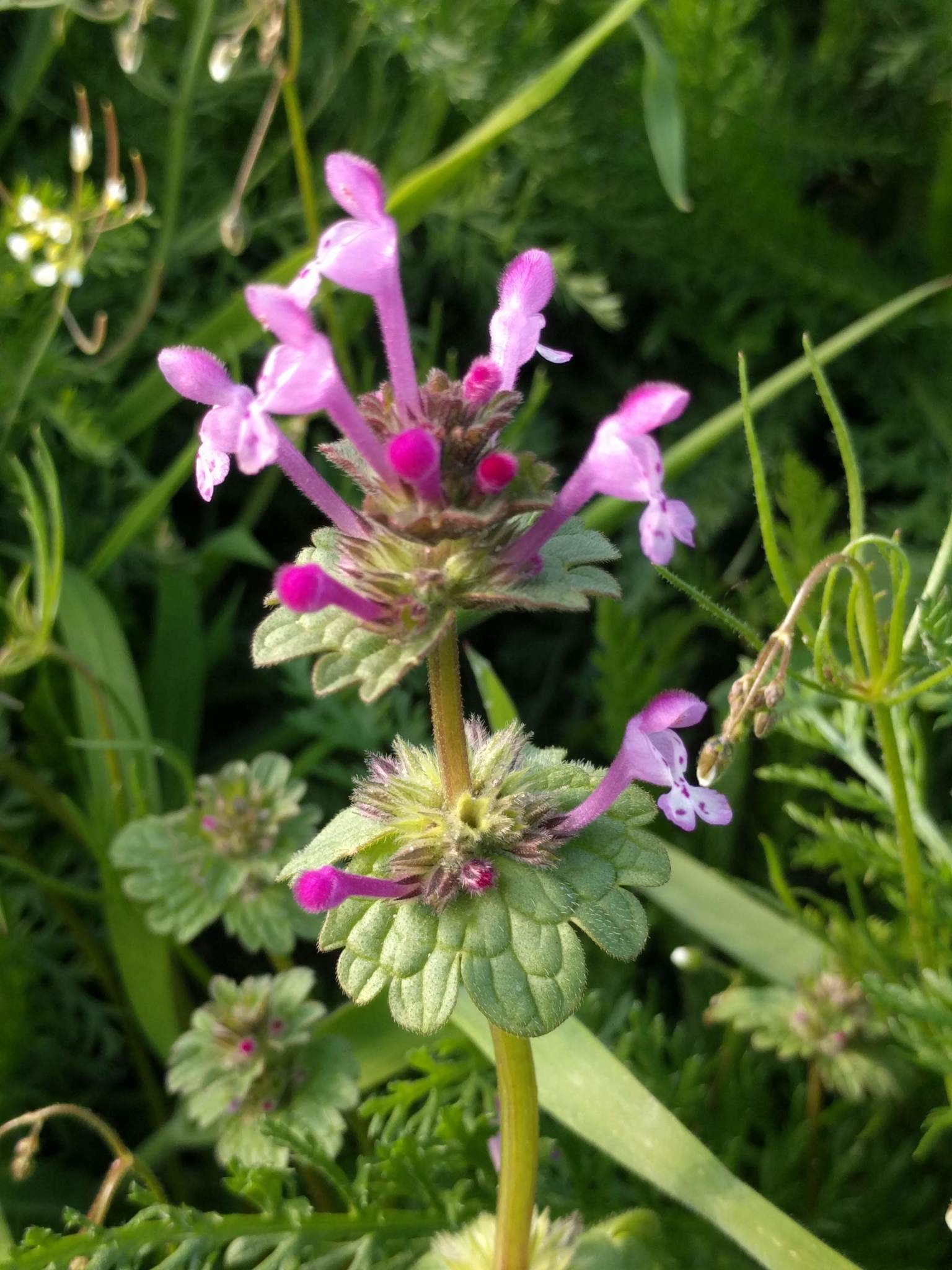
Henbit Deadnettle (Lamium amplexicaule) is a branching weedy plant with square stems. It blooms in early spring with small bright lavender flowers that have red spots. It has stalkless leaves. The leaves under the flower clusters are rounded and close to the ground.
You are likely to see this wildflower in gardens, waste areas, fields, roadsides, and railroads.
27. Bloodroot

Bloodroot (Sanguinaria canadensis) is a stemless wildflower with a fleshy finger-like tuber that has red-orange juice. The tuber produces a flower stalk and a deeply scalloped, gray-green basal leaf. The leaf will unfurl when the solitary flower blooms.
Once the flower fades, the leaves continue growing until mid-summer. After this, the plant goes dormant and the leaves turn yellow and wither. The plant then blooms the following spring.
Flowers open as the leaves start unfurling. When it opens, two sepals fall. The flowers have up to sixteen white petals that are uneven in size and length. It has numerous yellow stamens. Each flower lasts up to two days, blooming from March to April.
28. Wingstem

Wingstem (Verbesina alternifolia), also known as yellow ironweed is a tall, weedy perennial found in woodland areas. In Missouri, you are likely to find this clump-forming wildflower in wood margins, thickets, meadows, sloughs, ditches, and near streams.
It has bright yellow daisy-like flowers that bloom from August to October. The flowers are on stiff, hairy stems that can grow to eight feet in height. The flowers have up to eight narrow bright yellow rays with a dark yellow center disc.
The leaves are rough and can grow to twelve inches. The leaf tissue extends down the stem of the plant.
29. Late Boneset

This common wildflower (Eupatorium serotinum) is late-flowering. It is a perennial with stems and leaves with short hairs. The leaves are lance-shaped and angled at the base. They have leaf stalks, tapering to sharp points and coarse tips.
Each leaf has three main veins with the side veins branching from the central vein. The flower heads have up to fifteen florets from August to October.
30. Butterfly Milkweed

Butterfly Milkweed (Asclepias tuberosa) is a rooted Missouri wildflower. This perennial plant can be seen in prairies, fields, glades, and woods throughout the state. It grows in a clump and can reach up to 2.5 feet in height. The clusters of bright orange to yellow-orange flowers sit on a hairy stem with lance-shaped leaves.
It does not have milky sap in the stems, unlike other milkweeds. The flowers produce a spindle-shaped seed pod that splits and releases wind-dispersed seeds. The seed pots are often used in dry flower arrangements. The flowers produce nectar for butterflies and are a food source for the monarch butterfly caterpillar.
31. American Black Elderberry

The American Black Elderberry (Sambucus canadensis) is native to North America. It is a deciduous, sprawling shrub that can grow to twelve feet in height. It can be found in moist woodlands, fencerows, roadsides, steam banks, and thickets throughout Missouri.
It produces lemon-scented white flowers in large clusters during June. The flowers produce black elderberry fruits in the late summer. The fruits are used for jellies, jams, and pie fillings.
It offers attractive flowers and interesting fruits, often used as shrub borders or screens. It is an excellent sprawling hedge.
32. Rue Anemone

Rue Anemone (Thalictrum thalictroides) is a native Missouri woodland wildflower with white flowers. It can grow to nine inches in height. The flowers have five petal-like sepals and green-yellow stamens. The flowers are in loose clusters above three-lobed leaves. Each flower has a stem.
Flowers sometimes have a pink color. It is a long-blooming spring flower with a delicate appearance. It is often seen on ridges and slopes.
33. Red Clover

The Red Clover (Trifolium pratense), also known as the purple clover, is a large, pink-purple clover that can be seen in pastures, lawns, and roadsides throughout Missouri. It is native to Eurasia and was introduced to North America in the 1600s.
This perennial wildflower has a short rootstock with upright stems that can be hairy or hairless. The leaves have three leaflets with a pale “V” in the center. The flowers are egg-shaped and can grow to 1.45 inches in diameter. There are up to one hundred and fifty florets per head. The petals are red, purple, or white, blooming from April to October.
34. Great Blue Lobelia

This native Missouri wildflower (Lobelia siphilitica) is a perennial, growing in moist to wet locations. You often see it along streams, swamps, low wooded areas, and meadows. It has light to dark blue, two-lipped flowers with three lobes on the lower lip.
The flowers come from an upper leaf axil. The leaf stalks are unbranched and can be three feet in height. The light green leaves are lance-shaped and finely toothed. This wildflower blooms in the late summer months.
35. Cut-leaved Toothwort

The Cut-leaved Toothwort (Cardamine concatenata) is a perennial wildflower. This single-stemmed flat has flowers occurring at the top of the stem. The flowers have white petals, though they can be lavender. The petals are large with four petals. They bloom from March to May.
The leaves occur at the midway of the stem and are divided into three narrow sections, pointed and toothed. This wildflower is common in ravines, valleys, and wooded slopes.
36. Japanese Honeysuckle

Japanese Honeysuckle (Lonicera japonica) is a perennial semi-evergreen wildflower that is native to Japan. It was introduced to North America in 1806 as ornamental ground cover. Escaping cultivation is now widely established throughout Missouri.
This wildflower forms dense mats, climbing shrubs and trees, and dominating tree canopies. It has fragrant white flowers that bloom from May to June. The flowers develop into purple-black fruit that appeals to birds, which helps to distribute the seeds.
This is an aggressive vine that can destroy herbaceous layers of any community it invades. It is established in forested areas.
37. Multiflora Rose

The Multiflora Rose (Rosa multiflora) is a medium-sized wildflower. It is a thorny shrub that grows by forming thickets. The leaves are dived into up to eleven leaflets, each oval and toothed on the edge.
This wildflower blooms from May to June with clustered white flowers. It produces small red fruits that remain on the plant into the winter months. The plant can grow to fifteen feet and have an eight-inch diameter.
You will see the multiflora rose in pastures, old fields, and along roadsides. It has a wide tolerance for different soil and lighting conditions. It was first introduced in 1886 as an ornamental rose, spreading to become an invasive species.
38. Garlic Mustard

Garlic Mustard (Alliaria petiolata) gives a garlic fragrance from all parts of the plant. The plant will flower when it reaches around two to four feet in height. It blooms from May through to June.
The plant produces one flowering stem, but it is possible to have up to ten stems from a single root. The flowers are small and white. Each flower has four petals that narrow at the base.
It has green kidney-shaped leaves at the base and stem leaves that are triangular and sharply toothed. This wildflower is often seen in savannas, roadsides, disturbed sites, and floodplain forests.
39. American Trumpet Vine
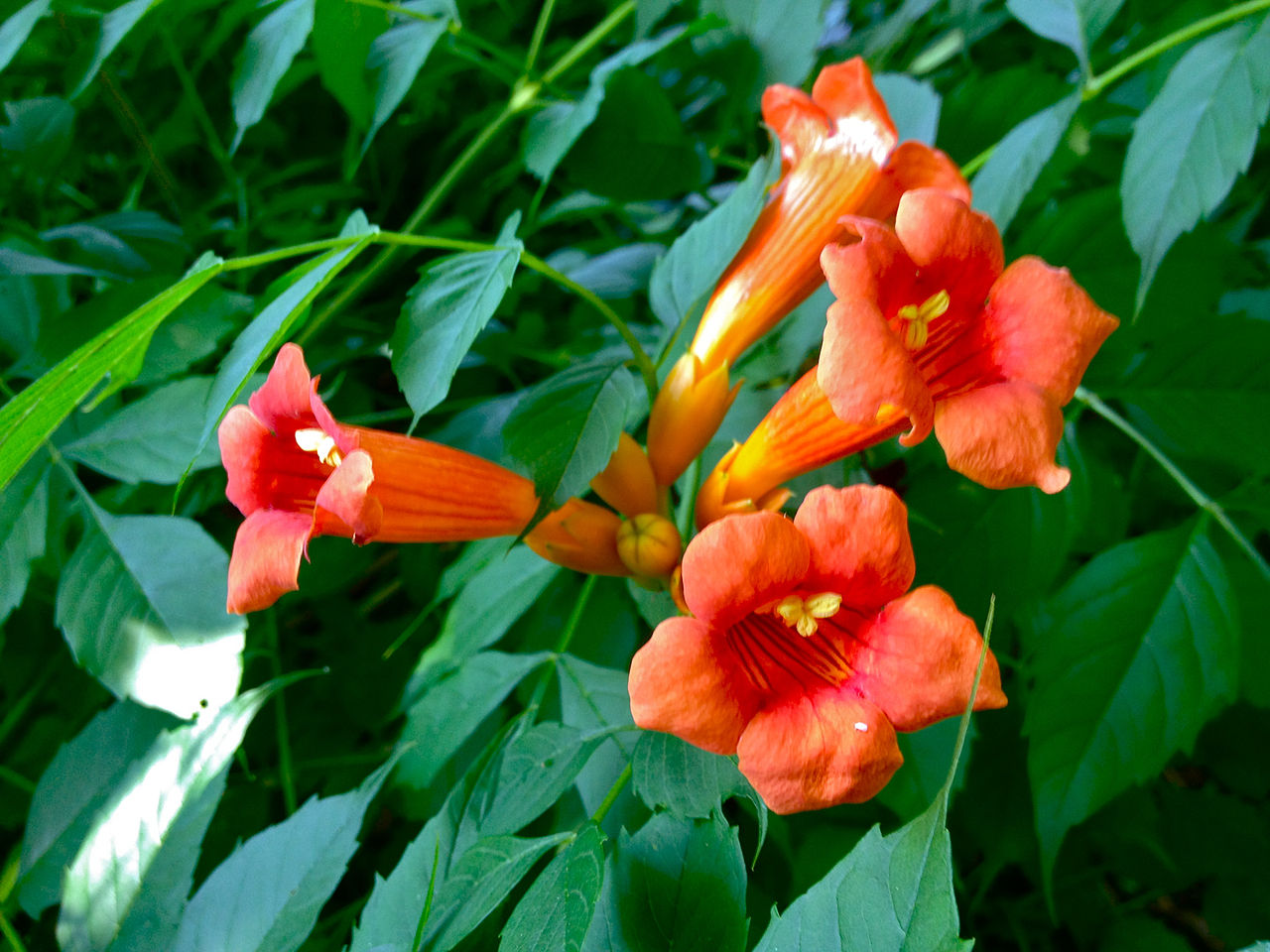
The American Trumpet Vine (Campsis radicans), also known as the trumpet creeper, is a multi-stemmed, deciduous vine that attaches to structures, climbing using aerial rootlets. It is native to Missouri, particularly the Ozark region. Today it has naturalized throughout the state.
This wildflower is a common site in Missouri, where it can be found along streams, roadsides, railroad tracks, thickets, and woods. It grows to forty feet with compound, dark green leaves. The leaves turn yellow in the fall.
It forms clusters of red trumpet-shaped flowers that can be seen from June to September. The flowers attract hummingbirds. This wildflower is useful when looking for quick cover for trellises and fences. It can be grown on the ground to cover rock piles and tree stumps.
40. Common Star-of-Bethlehem

This wildflower (Ornithogalum umbellatum) has clusters of flowers on the tips of stems that are one foot in height. The flowers have three sepals and three petals, which form an attractive star in bright white with green lines on the underside. You will see this wildflower throughout Missouri from April to June.
The grass-like leaves are dark green and roll inwards with a white central vein. The leaves turn yellow and wither when the weather gets hot. You can find this wildflower in pastures, forests, suburban lawns, and disturbed areas.
41. Dutchman’s Breeches

Dutchman’s Breeches (Dicentra cucullaria) is a graceful early spring wildflower, native to Missouri. It is found on forest floors, slopes, valleys, ravines, along streams, and in rocky woods. It has fern-like green foliage and white-yellow-tipped flowers.
The flowers occur from leafless stems, just above the foliage in early spring. The plant can grow to twelve inches in height.
42. Eastern Beebalm

The Eastern Beebalm wildflower (Monarda bradburiana) is common in Missouri in dry and acid soils in woods, glades, and rocky areas. It is a native perennial that is clump-forming, belonging to the mint family. It grows to two feet with tubular pink to white flowers with purple spots.
The flowers attract butterflies and bees. The gray-green leaves are oblong and toothed, often used in teas. This wildflower has a long summer bloom period. It is great in herb gardens to add color and contrast.
43. Wild Geranium
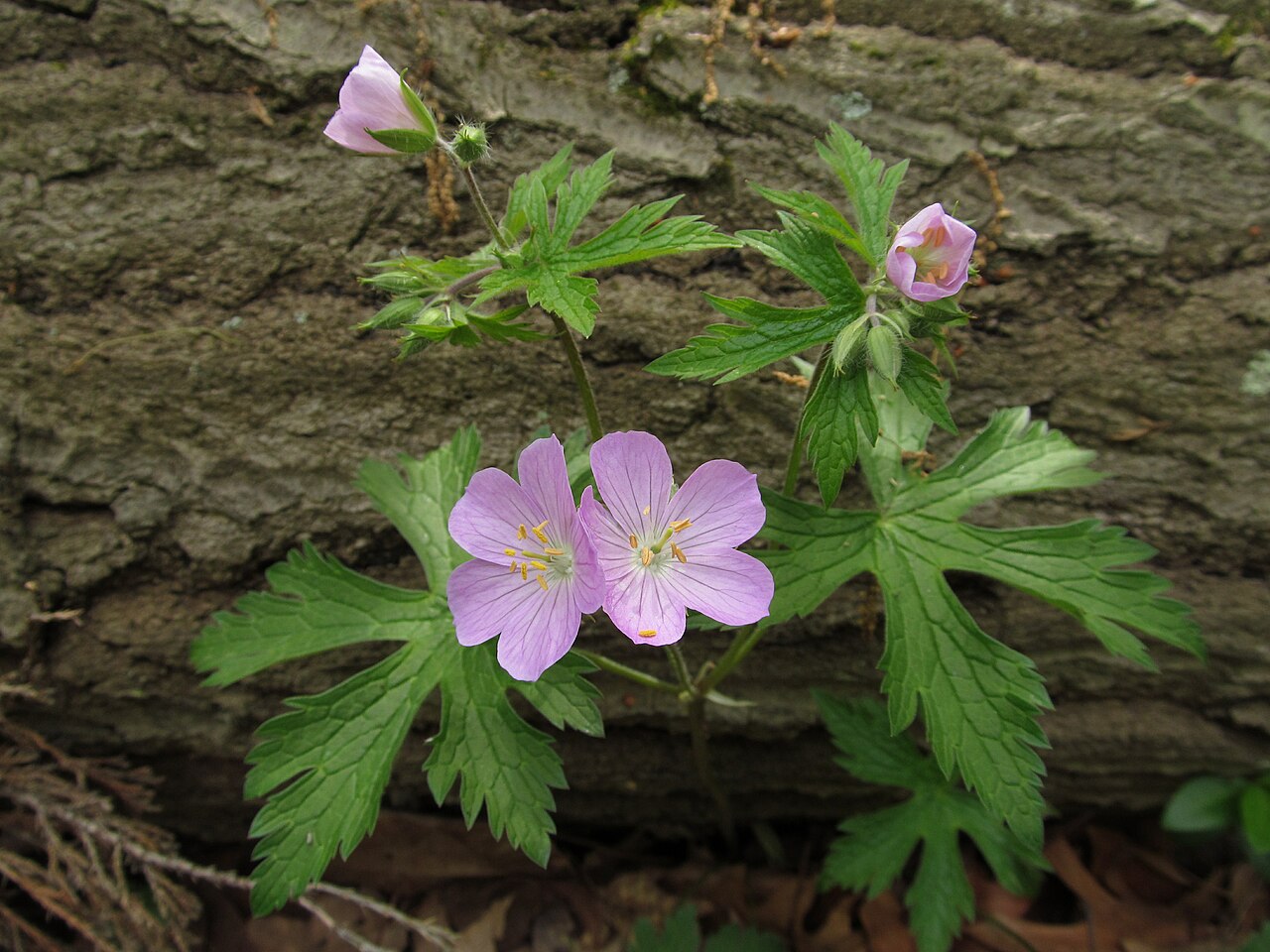
The Wild Geranium (Geranium maculatum) is a clump-forming woodland perennial, native to Missouri. You will see it in woods, shaded roadside areas, and thickets. It forms foliage that grows to twenty-four inches in height and eighteen inches in width.
The pink to lilac saucer-shaped five-petal flowers appear in spring for up to seven weeks. The dark green leaves are deeply cut. The flowers give way to seed capsules.
44. Rose Vervain

Rose Vervain (Glandularia canadensis), also known as rose verbena is a Missouri native wildflower. This perennial wildflower is seen in fields, rocky glades, roadsides, waste areas, and pastures throughout the central and southern parts of the state.
This sprawling and clumping plant can grow to eighteen inches and spread quickly. It has flat-topped clusters of rose-pink to rose-purple flowers that appear in the late sprint to late summer. The dark green leaves are deeply lobed with triangular bases.
45. Red Columbine

Red Columbine (Aquilegia canadensis) is a Missouri spring wildflower that is seen on rocky ledges, slopes, and rocky woods throughout the state. It has bell-like red and yellow flowers and delicate foliage. It remains attractive throughout the summer in moist soils.
The flowers attract hummingbirds, which is why it is popular for woodland gardens, cottage gardens, and open shade gardens.
46. Bitter Wintercress

Bitter Wintercress (Barbarea vulgaris) is a leafy plant that grows to two feet in height. The flowers are bright yellow, comprising four petals in a cross-like formation. It blooms from April to June.
The feather-like leaves are oval or circular. The fruit is a long seedpod that forms at the base of the cluster, as new flowers open at the tips of the flower stalk. It is a common wildflower in waste areas, open and disturbed areas, fields, and pastures. It is originally from Asia and Europe and has naturalized in North America.
47. Purple Coneflower

The Purple Coneflower (Echinacea purpurea) is a rough and hairy herbaceous perennial plant that is seen in meadows, open woods, and prairies. It can grow to four feet in height with daily-like purple coneflowers that bloom in summer.
The flowers sit on top of stiff stems with coarse dark green leaves. When the plant dies, the dead flower stems remain erect during the winter months.
48. Violet Woodsorrel

The Violet Woodsorrel (Oxalis violacea) is a common Missouri wildflower that is found throughout the state. This native wildflower can be seen on glades, rocky open woods, prairies, and fields.
It is a stemless plant, growing to eight inches in height with long-stemmed leaves and leafless flower stalks. The leaves have heart-shaped green leaflets that are purple underneath. The five-petaled flowers are white, pink, lavender, or violet.
49. Brown-eyed Susan

Brown-eyed Susan (Rudbeckia triloba) is a weedy and hairy wildflower, native to New England, Georgia, Minnesota, and Oklahoma, In Missouri, it is found along streams, thickets, and rocky slopes.
This densely-branched wildflower grows to three feet in height with yellow daisy-like flowers with a brown-purple center. The flowers bloom from summer to fall.
It has thin leaves that are roughly textured. It is commonly used in cottage gardens, wildflower meadows, and native plant gardens.
50. Low Smartweed
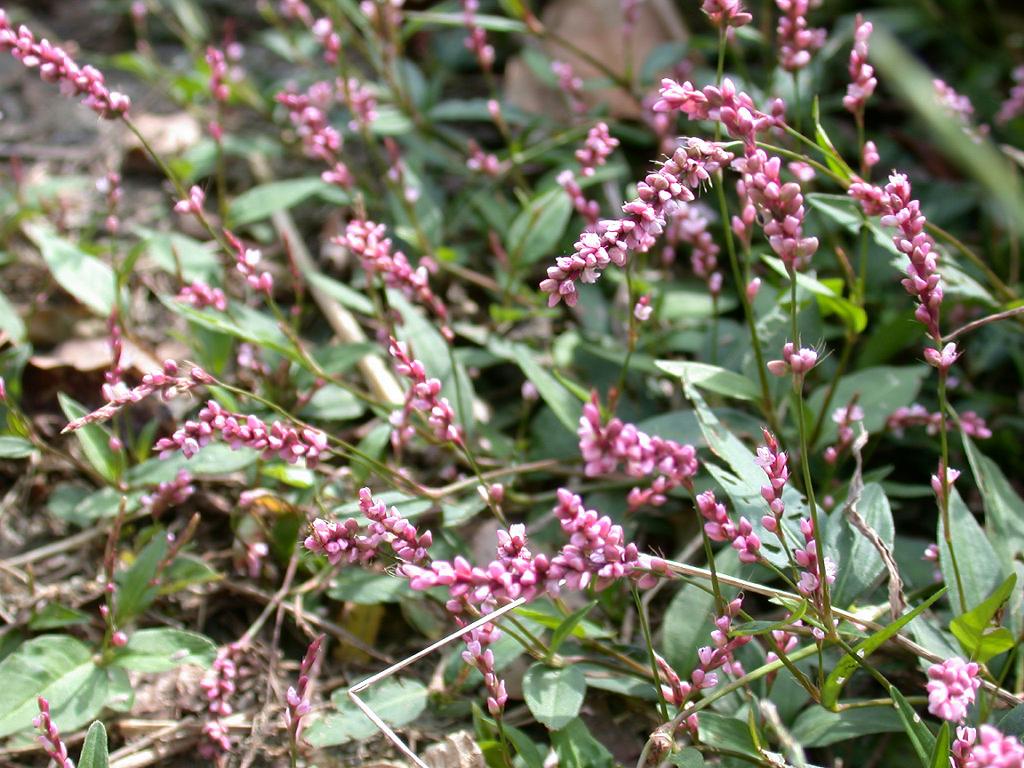
Low Smartweed (Persicaria longiseta) is an aquatic or terrestrial perennial wildflower that forms dense colonies and covers large areas. The erect stems, branches, and sprawl as they grow. The flowers are pink and showy, they are sometimes white. They bloom from June to October.
The leaves are sharply pointed on leaf stems. This wildflower is found in wet and open land, steam sides, lake shores, ponds, and sloughs.
51. Beefsteak Plant

The Beefsteak Plant (Perilla frutescens) is a bushy annual wildflower that is native to Southeast Asia and the Himalayas. It grows to three feet with wrinkled green leaves, some may be tinged with purple. The leaves are very aromatic.
The flowers are two-lipped and nettle-like with spiky inflorescences at the stem. They bloom from August to October. The plant has escaped gardens and naturalized throughout central and southern Missouri.
The fresh leaves of the beefsteak plant are often used in Oriental cooking.
52. Blue Mistflower

The Blue Mistflower (Conoclinium coelestinum) is a late summer to fall blooming wildflower. This herbaceous perennial is native to the Eastern United States. It spreads aggressively, growing to two feet in height with purple stems with coarse teeth.
The flowers are small and fluffy. The flowers are blue-purple and bloom from July to October with dense, flat clusters. In Missouri, they are commonly found south of the Missouri River in wet woods, streams, ponds, ditches, and bluff bases.
53. Painted-cup Paintbrush
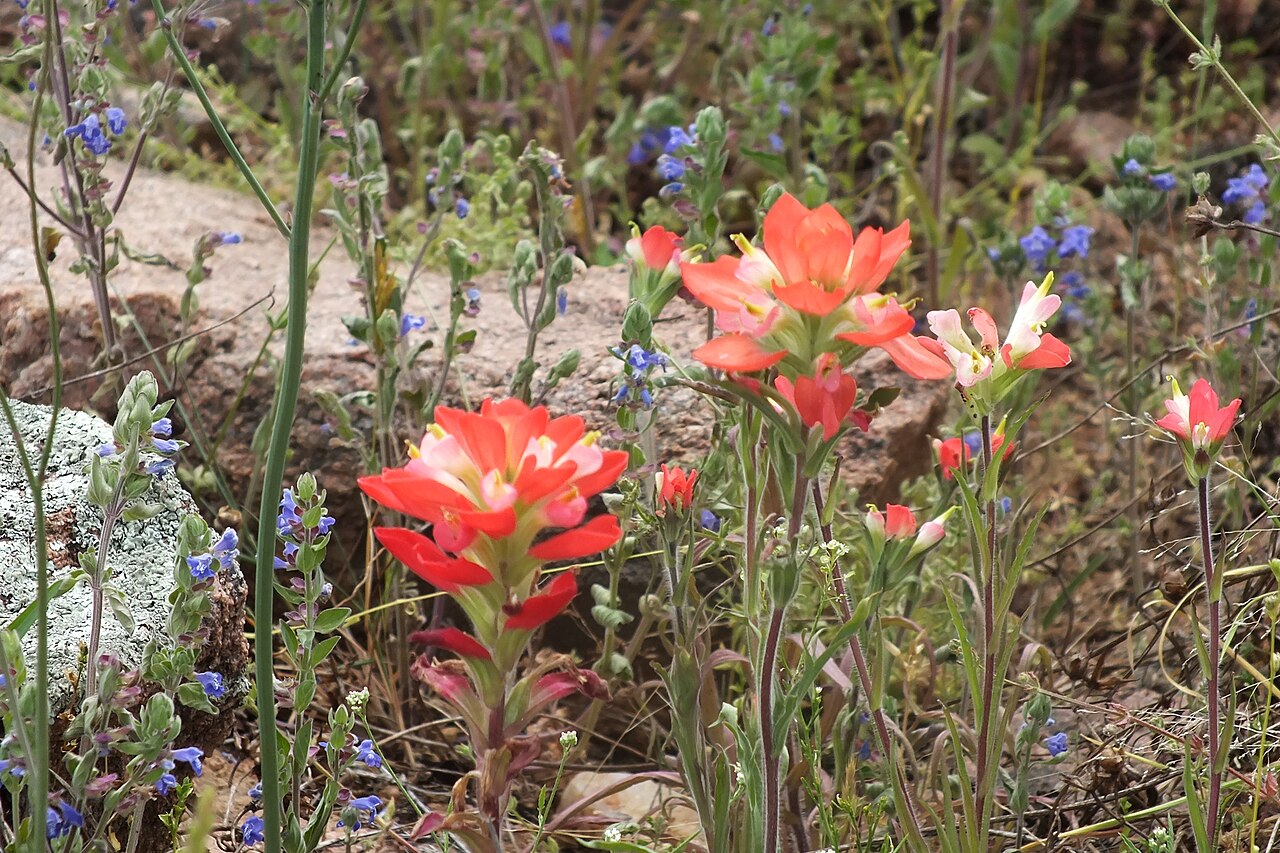
The Painted-cup Paintbrush (Castilleja coccinea) is a biennial wildflower and a Missouri native. It can grow to 1.5 feet in height and is often seen in prairies, moist and open woodlands, steam banks, thickets, and glades in central, southern, and eastern Missouri.
It has fan-shaped orange to red colored flowers at the top of the stems. It blooms from spring to early summer. The medium green leaves are lance-shaped in the basal rosette and divided into five deep, narrow lobes on the upper stem.
Further Reading: